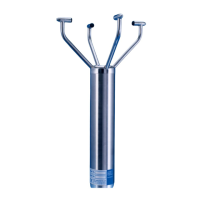Gill Instruments Ltd
_____________________________________________________________________________________________________________
________________________________________________________________________________________________
WindObserver II Page 47 Issue 18
Doc. No. 1390-PS-0004 January 2009
10.4. Returning unit
If the unit has to be returned, it should be carefully packed in the original packaging and
returned to your authorised Gill distributor, with a full description of the fault condition.
10.5. Status (error) codes
The Status code is sent as part of each wind measurement message.
Code Status Condition
00 OK Sufficient samples in average period
60
OK and heating
enabled
Sufficient samples in average period
A OK NMEA data Acceptable
01 Axis 1 failed Insufficient samples in average period on U axis
02 Axis 2 failed Insufficient samples in average period on V axis
04 Axis 1 and 2 failed Insufficient samples in average period on both axes
08 NVM error NVM checksum failed, data could be uncalibrated.
09 ROM error ROM checksum failed, data could be uncalibrated.
10 System gain at max. Inaccurate data likely
50 Marginal system gain Data valid, but marginal operation
51
Measurement average
building.
Data valid but warns that average period not reached
when averaging used.
62
Heating current tripped
or electronic failure,
Valid data still output
63
Heater Thermistor open
circuit
Valid data still output.
65
Heating element open
circuit
Valid data still output, Heater Element or Heater
PSU has dropped out/failed
V NMEA data Void Invalid data output
10.6. Bench test
Couple the WindObserver II to the host system and power supply, using a known working
test cable.
Check that the unit is correctly configured by going into Configuration mode and using D3
See Section 9.3 Checking the Configuration.
Check for normal output data, and that the Status Code is OK – 00, 60 or A (for NMEA
format).
If the status code is other than these, refer to Section 10.5 Status (error) codes.
Use an office fan or similar to check that the unit is sensing wind, turning the unit to
simulate changing wind direction and to check that both axes are functioning.
Note that this a quick functional test. There are no calibration adjustments; the unit is
designed NOT to require re-calibration within its lifetime. Gill has provided and Integrity
Check, see next page for details.

